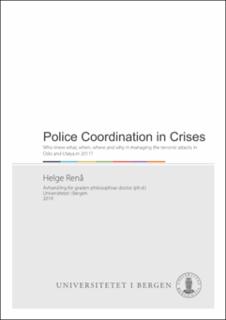| dc.description.abstract | Why did not the police mobilize more capacities more swiftly on 22 July, 2011? And why was there a lack of coordination by the police in its response to the two terrorist attacks (“22/7”)?
Building on a unique and rich set of data material that document the sequence of events as they happened in real time, this thesis challenges the widely shared view of a failed police response, which has been the dominant perspective in Norway in the aftermath of 22/7. Many of the decisions and actions that were taken by the police certainly seem unreasonable and contradictory in hindsight. However, this thesis argues that what may seem as contradictory actions in crisis responses at the aggregate level stem from actions that were reasonable for the individuals at the time they enacted their actions given their preconceptions of the roles they had in the organization, their designated role in the actual operation, their physical location and what information they had at that point in time.
The goal of this thesis goes beyond providing a rich descriptive account of how the police responded to 22/7, and contends that existing research on crisis coordination has paid too little attention to the notion of time. Answering the “why”-question of crisis coordination is not only a matter of examining the “what” and the “how”, we also need to examine and take into account the “when”. Theoretically, the argument of this thesis differs from conventional accounts on coordination by taking into account the multidimensional role of time in crisis coordination. This is done by taking time as the locus for the analysis, and developing a multiple streams framework. Crisis coordination is not perceived solely as a sequential, linear process, but as a process that comprises streams of problems, capacities and information that may (or may not) get coupled on many different locations at different points in time as the crisis response proceed.
The thesis finds that the pre-crisis coordination, i.e. pre-existing crisis coordination structures and practices, significantly constrained the possibilities for the police to enact a swift mobilization, and a coordinated response to 22/7. Moreover, an important part of the explanation why the police coordinated its response to the terrorist attacks as it did is the timing of (directive) actions and couplings: when actions to bring about coordination was taken; what capacities were coupled to what problems when; and, what information was coupled to whom when – who knew what, where and when. | en_US |
